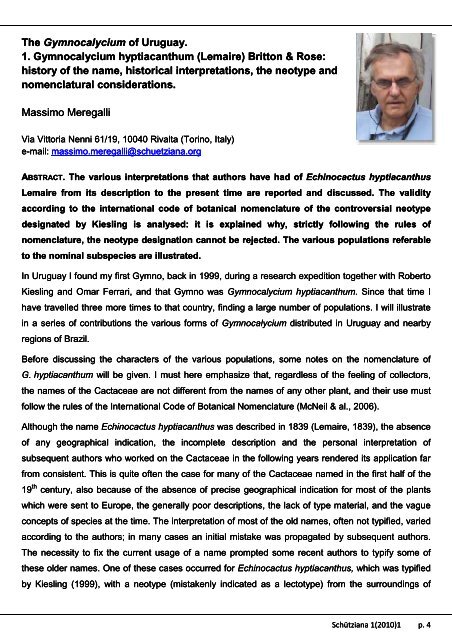Volume 1, Issue 1, 2010 ISSN 2191-3099 - Schütziana
Volume 1, Issue 1, 2010 ISSN 2191-3099 - Schütziana
Volume 1, Issue 1, 2010 ISSN 2191-3099 - Schütziana
You also want an ePaper? Increase the reach of your titles
YUMPU automatically turns print PDFs into web optimized ePapers that Google loves.
The Gymnocalycium of Uruguay.<br />
1. Gymnocalycium hyptiacanthum (Lemaire) Britton & Rose:<br />
history of the name, historical interpretations, the neotype and<br />
nomenclatural considerations.<br />
Massimo Meregalli<br />
Via Vittoria Nenni 61/19, 10040 Rivalta (Torino, Italy)<br />
e-mail: massimo.meregalli@schuetziana.org<br />
ABSTRACT. The various interpretations that authors have had of Echinocactus hyptiacanthus<br />
Lemaire from its description to the present time are reported and discussed. The validity<br />
according to the international code of botanical nomenclature of the controversial neotype<br />
designated by Kiesling is analysed: it is explained why, strictly following the rules of<br />
nomenclature, the neotype designation cannot be rejected. The various populations referable<br />
to the nominal subspecies are illustrated.<br />
In Uruguay I found my first Gymno, back in 1999, during a research expedition together with Roberto<br />
Kiesling and Omar Ferrari, and that Gymno was Gymnocalycium hyptiacanthum. Since that time I<br />
have travelled three more times to that country, finding a large number of populations. I will illustrate<br />
in a series of contributions the various forms of Gymnocalycium distributed in Uruguay Uruguay and nearby<br />
regions of Brazil.<br />
Before discussing the characters of the various populations, some notes on the nomenclature of<br />
G. hyptiacanthum will be given. I must here emphasize that, regardless of the feeling of collectors,<br />
the names of the Cactaceae are not different from the names of any other plant, and their use must<br />
follow the rules of the International Code of Botanical Nomenclature (McNeil & al., 2006).<br />
Although the name Echinocactus hyptiacanthus was described in 1839 (Lemaire, 1839), the absence<br />
of any geographical indication, the incomplete description and the personal interpretation of<br />
subsequent authors who worked on the Cactaceae in the following years rendered its application far<br />
from consistent. This is quite often the case for many of the Cactaceae named in the first half of the<br />
19 th 19 century, also because of the absence of precise geographical indication for most of the plants<br />
th 19 century, also because of the absence of precise geographical indication for most of the plants<br />
th century, also because of the absence of precise geographical indication for most of the plants<br />
which were sent to Europe, the generally poor descriptions, the lack of type material, and the vague<br />
concepts of species at the time. The interpretation of most of the old names, often not typified, varied<br />
according to the authors; in many cases an initial mistake was propagated by subsequent authors.<br />
The necessity to fix the current usage of a name prompted some recent authors to typify some of<br />
these older names. One of these cases occurred for Echinocactus hyptiacanthus, which was typified<br />
by Kiesling (1999), with a neotype (mistakenly indicated as a lectotype) from the surroundings of<br />
<strong>Schütziana</strong> 1(<strong>2010</strong>)1 p. 4



